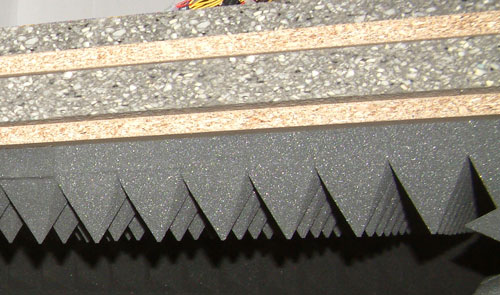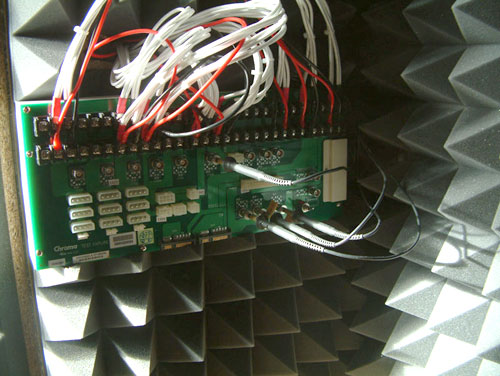Thermaltake TR2 QFan Series
by Christoph Katzer on November 19, 2008 3:00 AM EST- Posted in
- Cases/Cooling/PSUs
Testing with the Chroma ATE Programmable Load

Our test equipment consists of two Chroma programmable DC Loads that enable us to test power supplies with an output of up to 1500W. The biggest advantage of the Chroma DC Loads is simply the high precision it provides. It can measure differences as small as 0.001V and 0.0001A, which will provide us with best-in-class results.
When programming the Chroma with specific amounts of load calculated according to the ATX norm, we are able to load power supplies to an exact percentage. We can now show results at every specific percentage needed. To get the best overview of a power supply, we load each unit with 10%, 20%, 50%, 80%, 100%, and 110% of the specified output. This is easy to calculate for a 1000W power supply: the 10% load is 100W and 110% load is 1100W. Remember that this is the amount of power the PSU delivers; due to inefficiencies, a power supply will actually draw more power from the wall.
Note: If you would like to know more about our testing methodology, equipment, and environment, please read our PSU testing overview.
We have added an additional 10% on the highest load to see how the units perform with overload. This test will be performed in all future reviews. The overload test is performed at room temperature as well as under more stressful conditions; to ensure we are not too cruel to the power supplies, we will keep the ambient temperature at 50°C in the stress test. Experience shows that many units can stand the overload at room temperature but will experience problems with higher temperature and overload together. Only the best-built units will survive this.

The Testing Environment
There is one flaw in testing power supplies with programmable loads while trying to measure the sound pressure levels at the same time. Because the programmable loads get very loud, there is no chance of hearing the power supply on the test stand. In order to make accurate measurements of the noise levels we needed a way to separate the test unit and the programmable loads. Our solution was to build a very thick box around the unit.

We concluded that a five-layer box with a total thickness of 6" (15cm) containing two layers of wood and three layers of special foam would suffice. It is designed as a box within a box. The inner box does not touch any part of the outer box, making it difficult for acoustic noise to pass through in the form of vibration. Each box is isolated on both sides with a layer of heavy foam that is normally used to insulate engines. On the inside we have an additional layer of 4" (10cm) thick pyramidal foam on every side of the box to eliminate the acoustic waves coming from the test object as well as we can.

To ensure a completely closed system we installed the printed circuit board that the connectors of the power supply are attached to inside the anechoic room/box. In other box designs, you would need to put all the cables through the wall. Unfortunately, that would result in the inside of the box not being fully isolated anymore. Our design keeps everything that needs to be connected inside of the box and maintains isolation.










36 Comments
View All Comments
Slomo4shO - Wednesday, November 19, 2008 - link
Would it be possible to include CORSAIR CMPSU-400CX, PC Power & Cooling Silencer PPCS420X, OCZ ModXStream Pro OCZ400MXSP, and OCZ ModXStream Pro OCZ500MXSP in your upcoming write-up?Christoph Katzer - Wednesday, November 19, 2008 - link
Yep, have them already here.Havor - Thursday, November 20, 2008 - link
Hi Christoph nice reviewBut if you really be cool if you would put all the tested PSU's in a database.
ware you can select a power rating (like say 400~450W) and see on a graf how all the PSUs performs in that W-rating
http://img03.picoodle.com/img/img03/3/11/20/f_PSUg...">http://img03.picoodle.com/img/img03/3/11/20/f_PSUg...
A other thing that would be nice would be if you would give all PSU a grade from 0~100 ware 100 would be a PSU perfect PSU <15db/100% eff./DC output perfect flat/temp <30c/PFC = 1/build quality perfect
And then turn it in a graf. and cross it whit personal most important part for HTPC builders that would be db, for people building a server it would be high % efficacy
Mr Perfect - Wednesday, November 19, 2008 - link
It would be interesting to know what Seasonic is up to these days. Their old S12 line was quite impressive in it's day.Oh, and anything that has more then just one 6pin PEG connector. Someone with a reasonably powered system might still want to hook in a 4870 or GTX260, seeing how games are generally GPU limited today.
Netcraazzy - Wednesday, November 19, 2008 - link
I'd love to see a head-to-head comparison between these PSUs and similar units from Antec, OCZ, Seasonic, Sparkle and others. I'm especially interested in the 400w-500w range.Amart - Wednesday, November 19, 2008 - link
Opinion seconded, well done with the review. I especially appreciate the attention to quality and ripple graphs, as these are of prime concern when recommending a PSU.